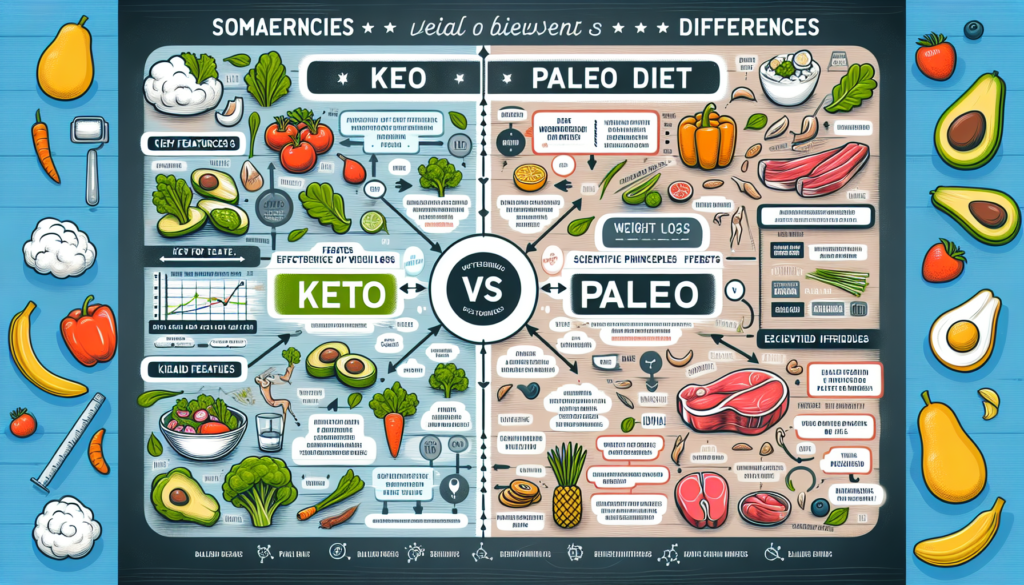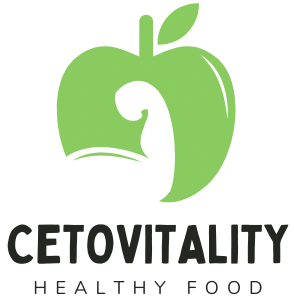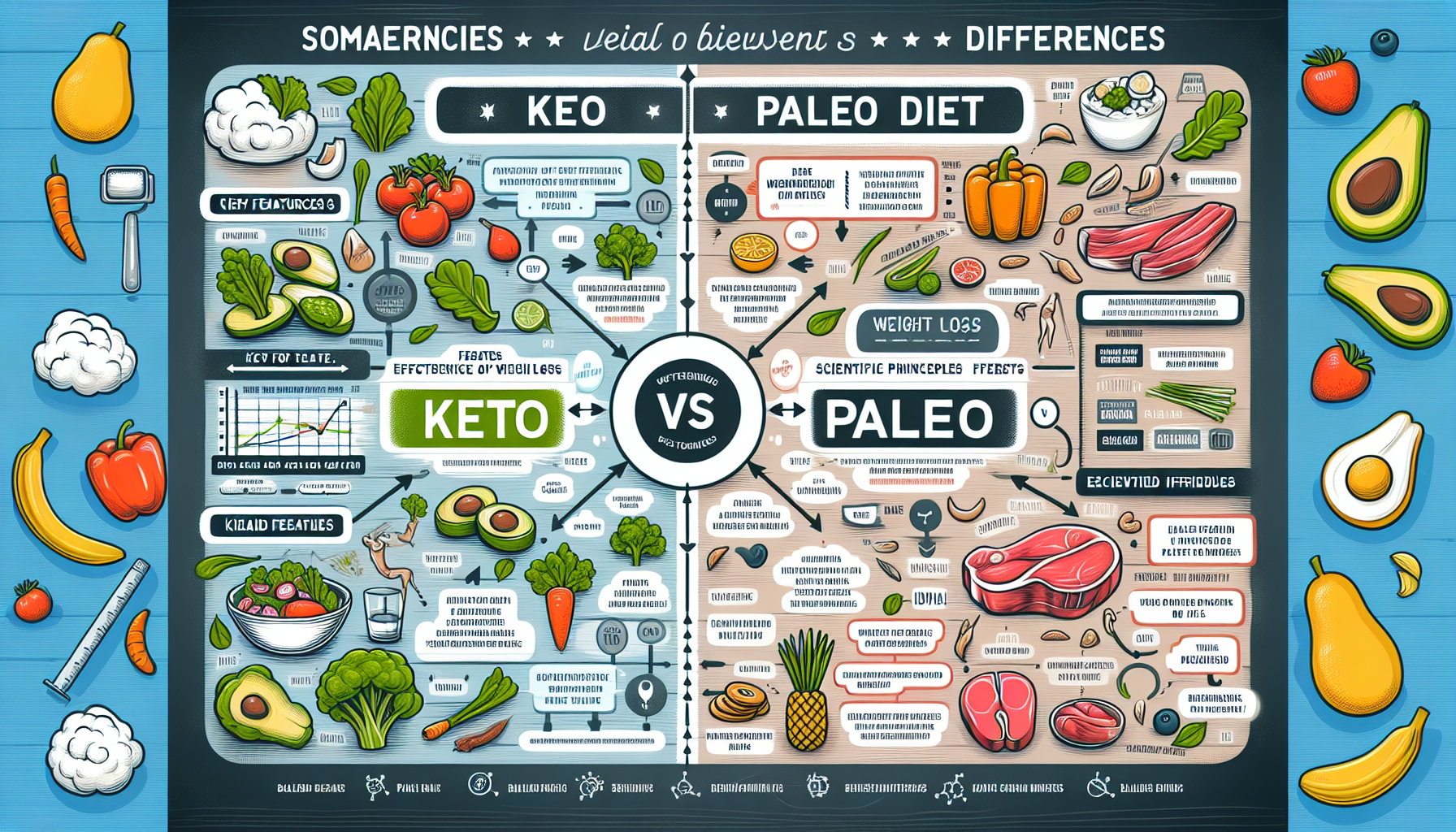Are you ready for a showdown? In the world of diets, two heavyweights go head to head: Keto and Paleo. Both these diets have been making waves in the health and wellness industry, claiming to offer amazing results. But which one is right for you? In this article, we will explore the differences between the Keto and Paleo diets, unveiling their pros and cons, so you can make an informed decision and choose the ultimate winner for your health journey. It’s time to buckle up and discover the ultimate showdown: Keto vs. Paleo diets.
Benefits of the Keto Diet
Weight Loss
The Keto diet is well-known for its effectiveness in promoting weight loss. By drastically reducing carbohydrate intake and increasing consumption of healthy fats, the body is forced to enter a state of ketosis. In this metabolic state, the body taps into its fat stores for energy, leading to a significant reduction in weight. Not only does the Keto diet help shed pounds, but it has also been shown to target stubborn belly fat, which is a common concern for many individuals.
Increased Energy Levels
One of the surprising benefits of the Keto diet is the surge in energy levels experienced by followers. When carbohydrates are limited, the body starts relying on fat as its primary source of fuel. Fat, being a more efficient and sustainable source of energy, provides a steady supply of fuel throughout the day. Many Keto enthusiasts report feeling more alert, focused, and energized after adopting this dietary approach.
Reduced Inflammation
Inflammation is at the root of many chronic diseases, and the Keto diet has been found to have anti-inflammatory effects. By promoting the consumption of whole, unprocessed foods and minimizing the intake of refined carbohydrates, the Keto diet helps reduce inflammation in the body. This can lead to a reduction in common inflammatory symptoms such as joint pain, skin issues, and digestive problems.
Improved Mental Clarity
Following a Keto diet has been linked to improved mental clarity and cognitive function. When the brain is fueled by ketones, which are produced during the breakdown of fat, it may operate more efficiently. Many individuals report enhanced focus, better concentration, and improved mental acuity while on a Keto diet. This can be particularly beneficial for individuals who need to perform mentally demanding tasks or have difficulties with brain fog.
Drawbacks of the Keto Diet
Limited Food Choices
While the Keto diet offers many benefits, it does come with some drawbacks. One major challenge when following a Keto diet is the limited food choices available. Since carbohydrates need to be severely restricted, high-carb foods such as bread, pasta, and many fruits are eliminated or severely limited. This can make it difficult to adhere to the diet in social situations or when dining out, as many commonly enjoyed foods are off-limits.
Keto Flu
When transitioning to a Keto diet, some individuals may experience what is commonly known as the “Keto flu.” This temporary phase can last anywhere from a few days to a couple of weeks and is characterized by symptoms such as fatigue, headache, irritability, and cravings. These symptoms arise as the body adjusts to using fat as its primary fuel source. While the Keto flu is a temporary inconvenience, it can be challenging to navigate during the initial stages of starting the diet.
Difficult to Sustain
Sustainability can be a challenge for many individuals on the Keto diet. The long-term compliance with such a restrictive dietary approach may be difficult for some, as it requires a significant overhaul of eating habits. The appeal of carbohydrates and the social aspect of food can make it tough to adhere to the Keto diet consistently. Additionally, the strict nature of the diet may not suit everyone’s lifestyle or personal preferences.
Potential Nutrient Deficiencies
Following a Keto diet can potentially lead to nutrient deficiencies if not properly managed. Since many high-carb foods are limited, it can be challenging to obtain adequate amounts of certain vitamins and minerals, including vitamin C, potassium, and magnesium. It is crucial for individuals on the Keto diet to focus on nutrient-dense foods and possibly consider supplementation to ensure they meet their nutritional needs.

Benefits of the Paleo Diet
Whole, Unprocessed Foods
The Paleo diet emphasizes the consumption of whole, unprocessed foods, mirroring the diet of our ancient ancestors. By avoiding processed foods, refined sugars, and additives, followers of the Paleo diet provide their bodies with a nutrient-dense and wholesome diet. This can lead to improved overall health, increased energy levels, and weight loss.
Improved Digestion
Many individuals experience improved digestion when following the Paleo diet. By excluding grains, legumes, and dairy, which can be challenging for some individuals to digest, the Paleo diet can alleviate digestive issues such as bloating, gas, and indigestion. The focus on fruits, vegetables, lean meats, and healthy fats can promote a healthy gut and support regular bowel movements.
Reduced Inflammation
Similar to the Keto diet, the Paleo diet is known for its anti-inflammatory properties. By avoiding grains, processed foods, and refined sugars, which can trigger inflammation in the body, followers of the Paleo diet can experience a reduction in inflammatory symptoms such as joint pain, skin conditions, and allergies. This can contribute to an overall improvement in health and well-being.
Stable Energy Levels
The Paleo diet promotes stable energy levels throughout the day. By prioritizing nutrient-dense foods and avoiding spikes in blood sugar caused by refined carbohydrates, the Paleo diet provides a steady supply of fuel to the body. This can help prevent energy crashes and keep individuals feeling energized and focused throughout the day.
Drawbacks of the Paleo Diet
Restrictive Eating Plan
One of the main drawbacks of the Paleo diet is its restrictive eating plan. The elimination of grains, legumes, and dairy can significantly limit food choices, making it challenging for individuals with specific dietary preferences or restrictions. This can be especially difficult for vegetarians or vegans, as they rely heavily on legumes and grains as their primary protein sources.
Difficult for Vegetarians or Vegans
The Paleo diet is not well-suited for vegetarians or vegans due to its emphasis on animal products and exclusion of legumes. Individuals who follow these dietary preferences may find it challenging to meet their protein needs and obtain a balanced nutritional profile while adhering to the Paleo diet. Alternative plant-based protein sources may need to be incorporated to ensure adequate nutrient intake.
Potential Nutrient Deficiencies
Similar to the Keto diet, the Paleo diet can potentially lead to nutrient deficiencies if not carefully planned and executed. The exclusion of certain food groups, such as dairy, grains, and legumes, can limit the intake of essential nutrients like calcium, vitamin D, and fiber. It is important for individuals on the Paleo diet to ensure they are obtaining a variety of nutrient-dense foods to meet their nutritional needs.
Higher Cost
The Paleo diet, in some cases, may come with a higher cost compared to other dietary approaches. Since the focus is on whole, organic, and grass-fed foods, the price tag can be higher than opting for conventionally grown produce or factory-farmed meat. This can make it more challenging for individuals on a limited budget to fully embrace the Paleo lifestyle.

Comparison of Macronutrient Ratios
Carbohydrate Restrictions
Both the Keto and Paleo diets involve significant restrictions on carbohydrate intake, but the Keto diet is much stricter in this regard. The Keto diet typically limits carbohydrate consumption to less than 50 grams per day, with the majority of calories coming from fat. On the other hand, the Paleo diet allows for a moderate intake of carbohydrates, mostly from fruits and vegetables, without specific targets or limits.
Protein Intake
Both diets prioritize adequate protein intake, although the Paleo diet tends to have a higher focus on protein consumption. The Paleo diet encourages the consumption of lean meats, seafood, and eggs, which are excellent sources of protein. The Keto diet also includes protein-rich foods but puts a larger emphasis on fat consumption for energy.
Fat Consumption
When it comes to fat consumption, the Keto diet surpasses the Paleo diet in terms of quantity. The Keto diet promotes high-fat intake, typically consisting of 75% to 80% of daily caloric intake. This is necessary to enter and maintain a state of ketosis. The Paleo diet also includes healthy fats from sources such as avocados, nuts, and seeds but does not emphasize such high levels of fat intake.
Different Approaches to Carbohydrate Intake
Ketosis
The Keto diet is designed to induce a state of ketosis, where the body primarily relies on fat for fuel instead of carbohydrates. This is achieved by severely limiting carbohydrate intake to a specific threshold, typically less than 50 grams per day. The body then starts breaking down stored fat into ketones, which are used as an energy source. This metabolic shift is responsible for the numerous benefits associated with the Keto diet.
Minimal Carb Restrictions
In contrast, the Paleo diet does not aim for ketosis and allows for a wider range of carbohydrate intake. While grains, legumes, and refined sugars are avoided, fruits, vegetables, and some starchy tubers are permitted. This provides a moderate level of carbohydrates necessary to meet energy needs without triggering the metabolic state of ketosis seen in the Keto diet.

Potential Health Risks
Ketoacidosis
One potential health risk associated with the Keto diet is the development of ketoacidosis, particularly in individuals with diabetes. Ketoacidosis is a dangerous condition characterized by high levels of ketones and acidity in the blood. It is important for individuals with diabetes or any underlying medical conditions to consult with a healthcare professional before starting a Keto diet to ensure it is suitable and safely monitored.
High Cholesterol Levels
The high intake of saturated fats in the Keto diet may lead to elevated cholesterol levels in some individuals. While the impact of dietary saturated fats on cholesterol levels is still a topic of debate, it is essential for those with existing heart conditions or a family history of high cholesterol to monitor their levels closely while following the Keto diet.
Kidney Problems
Some studies suggest a potential link between the Keto diet and kidney problems. The high intake of protein in the Keto diet can put additional strain on the kidneys, particularly in individuals with pre-existing kidney issues. Proper hydration and regular monitoring of kidney function markers are essential for individuals on the Keto diet to safeguard their kidney health.
Potential Nutrient Deficiencies
Both the Keto and Paleo diets have the potential to lead to nutrient deficiencies if not carefully planned and executed. The exclusion of certain food groups or the limited variety of foods can result in inadequate intake of essential nutrients. It is crucial to ensure a diverse and well-balanced diet, including supplementation if necessary, to avoid nutrient deficiencies.
Sustainability and Long-Term Effects
Keto Diet
The sustainability of the Keto diet is a topic of debate. While some individuals find long-term success and are able to maintain the diet as a lifestyle, others may struggle with the strict limitations and eventually revert to their previous eating habits. It is important to consider individual preferences, lifestyle factors, and long-term feasibility when embarking on the Keto diet.
Paleo Diet
The Paleo diet offers a more sustainable approach for many individuals. As it allows for a wider range of food choices and flexibility, it can be easier to maintain as a long-term lifestyle. It promotes a balanced approach to eating whole, unprocessed foods, which aligns well with common dietary recommendations for overall health improvement.

Individual Variations and Personal Preferences
Biochemical Differences
Each individual has unique biochemical differences that may impact their response to different dietary approaches. Some people may thrive on a Keto diet, while others may not experience the same benefits or may face more challenges. It is important to listen to your body and adapt your diet to suit your specific needs and preferences.
Cultural and Social Factors
Cultural and social factors can significantly impact an individual’s ability to adhere to a specific diet. The Keto diet, with its strict carbohydrate restrictions, may be challenging for individuals from cultures where grains and carbohydrates play a central role in their cuisine. Additionally, social gatherings and dining out may require special considerations and adjustments when following a specific diet plan.
Taste and Food Preferences
Personal preferences, including taste and food preferences, play a vital role in determining the sustainability and success of a diet. Some individuals may find the Keto diet unappealing due to the restricted food choices or excessive reliance on fats. The Paleo diet, with its emphasis on whole, unprocessed foods, may align better with the taste preferences of many individuals.
Combining Elements of Keto and Paleo
Using Keto Principles on a Paleo Diet
It is possible to combine elements of the Keto and Paleo diets by incorporating Keto principles within the framework of a Paleo diet. By prioritizing healthy fats and reducing carbohydrate intake to a moderate level, individuals can potentially achieve the benefits of both dietary approaches. This allows for more flexibility in food choices while still reaping the advantages of ketosis and the nutrient-dense nature of the Paleo diet.
Including Paleo-Friendly Foods in a Keto Diet
Similarly, individuals following a Keto diet can incorporate Paleo-friendly foods to enhance nutrient intake and diversity. By including more fruits, vegetables, and nutrient-dense sources of protein, individuals can benefit from the additional nutrients and fibers provided by these foods. This can help address potential nutrient deficiencies and improve the overall nutritional profile of a Keto diet.
In conclusion, both the Keto and Paleo diets offer unique benefits and drawbacks. The Keto diet promotes weight loss, increased energy levels, reduced inflammation, and improved mental clarity. However, it requires strict carbohydrate restrictions and may be challenging to sustain long-term. The Paleo diet prioritizes whole, unprocessed foods, improved digestion, reduced inflammation, and stable energy levels. It can be restrictive for vegetarians or vegans and may also pose challenges in meeting certain nutrient needs. Considering personal preferences, individual variations, and potential health risks, it may be beneficial to combine elements of both diets or find a balance that suits your lifestyle and health goals. As with any dietary change, it is advisable to consult with a healthcare professional or registered dietitian to ensure that the chosen approach meets your specific needs and supports your overall well-being.

